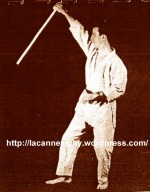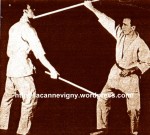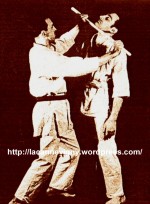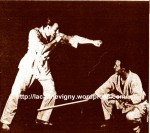In the history of American close combat there have been many individuals that have taught methods of stick fighting including -Fairbairn, Styers, Brown, O’Donnell and Applegate etc. However one of the best jiu jitsu and close combat experts during WW2 taught a nice system of stick fighting distinctively different to the above mentioned gentlemen.
Charles Yerkow was a second dan ranked judoka, jiu-jitsu instructor, a hand to hand close combat instructor, a fencer, and last but not least an expert in stick fighting. In 1942 Yerkow wrote his series”Complete Jiu Jitsu Library,” these classic books covered many aspects of judo, jiu jitsu, close combat, self defense and a rather interesting chapter on stick play.
While Yerkow indicates in his book that the system was a mixture of kendo and the West Indian stick play methods it bears little relationship to either. Nor are the skills based on judo, kendo, or any judo/ jiu jitsu weapon. After further reading Yerkow indicates that the method was actually based on techniques perfected through out the years and eventually utilized by the Indian police force. This is the first connection we see to H.G. Lang and Pierre Vigny.
Yerkow writes about his system of stick play being a versatile one and its principles adaptable to any stick size. However for clarity his instructional photos depict the use of a ‘cane’ sized stick. Yerkow recommends that if armed with a walking stick one should hold it at the tapered end and use the thick end- be it shaped with a knob – as the striking area. He indicates further that the walking stick can be used as a striking object or a thrusting tool. One of his first instuctions is the use of a back hand knee cut delivered along a horizontal plan against an unarmed opponent. This blow is almost non telegraphic and uses a low squatting action to affect a strike that requires little effort to drop a human being. Incidentally this same knee cut was also favoured by another Vigny stick fighting exponent/ admirer – Percy Longhurst
Yerkow goes on to mention that a cane can be used with both hands gripping either end with the palms down- a standard feature of the Vigny system. With both hands pronated 3 important factors come into play. The first, you can cut or strike with the stick by letting go of either hand. Second, you can execute two handed brace blocks along vertical and horizontal lines without compromising your grip. And last, but not least, it shows that Yerkow was either trained in the Vigny system or was intelligent enough to reconstruct its use based on available manuals and his own sabre fencing back ground.
The double handed stick play featured in the Vigny system is particularly effective for ‘all in fighting.’ Two handed thrust can be delivered to the groin, chin and abdomen while two handed bar smashes under the chin often result in “hors de comba.’
The next grouping of skills that Yerkow covers is the important figure eight stick exercise also found in Lang’s “Walking Stick Method of Self Defence” manual and some sabre books. These exercises are designed to both stretch and strengthen the muscles of the wrist, forearm region and also provide methods of attack and defence. Like the Vigny method the hand is kept above the head while performing these exercises. This provides the ability to deliver head blows, upper cuts and hand hits, it also teaches you to use these techniques from the high guard position.
Next Yerkow teaches a horizontal circling exercise above your head. He writes that by practising this circular exercise you can throw cuts up and down the body by using squatting action of the legs. Following this he instructs students how to hit across the body with the cane which is employed to clear any type of crowd in front or to either side of you.
In the last section of his chapter covering stick play Yerkow shows several examples of parrys from the high guard and explains that after a parry all of the molinets , swings and twirling exercises can be used as ripostes against the opponent’s vital targets. Yerkow also demonstrates a very efficient move against a boxer in which he cuts at the inner tibia while squatting to avoid a fast jab to the face. The chapter concludes with a listing of nerve centres for which to strike or thrust with your cane.
In conclusion the entire chapter is a tribute to the effectiveness of the walking stick method of Pierre Vigny. A method that gained prominence in Europe from the late 1800s and one that would make inroads into India from 1915, later to become an official system of stick fighting for the US army (by way of Yerkow) and during the 1940s taught to Jewish warriors in Palestine prior to the birth of Israel. Yerkow’s chapter on stick play is recommended reading for historians and practitioners of Pierre Vigny’s walking stick combative method.



